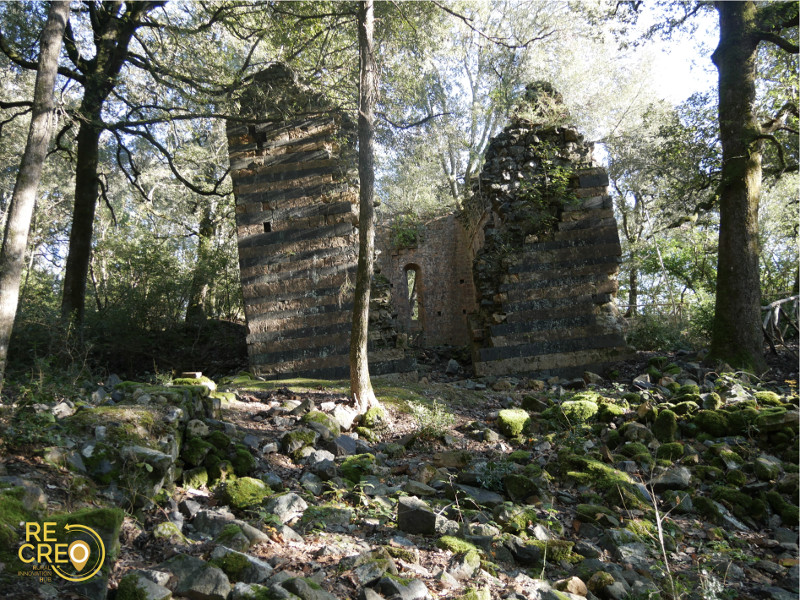


The ruins of the leaning hermitage
The perfect linear realization of the Romanesque complex, in the alternation of pink and black lines, contrasts even more with the decay of the imposing hermitage which, although so inclined - there are those who claim it has a record slope overcoming the Pisan Tower - and mostly collapsed on itself, it continues to dominate with dignity the tree-lined and sunny plateau on which it has rested since the 12th century.
The hermitage, which has lent one of its names to the valley, overlooks the gorge to the south crossed by the Fosso del Conventaccio, currently the only sound source that breaks into the evocative silence that surrounds the hermitage and the wood.
Walking around and inside it, one appreciates the good fortune of being able to admire it still standing with its skeleton. Yes, today the roof is missing, which simply covered the single nave with a barrel vault and with a truss architecture of wooden beams, the entrance is no longer made up of a door but of a breach that spreads to " V” from the bottom to the upper edges; of the furnishings, of the crucifixes, of the candelabra there is no longer a trace.
However, to give new life to the hermitage, small plants of all kinds and small trees from which bricks have fallen rise among the cracks, or in the internal niches, or above the capitals of the pilasters that once supported the arch of the nave , or at the base of the single lancet windows, whose roots slowly creep between one block and another, breaking the rhythm of symmetries that must have been so accurate.
The choice of the stones, and therefore of the colours, is of exquisite harmony, which is by no means accidental or purely aesthetic. In fact, as happens for most of the sacred complexes, the marble or other stones come from what the local resources offered. Indeed, it could perhaps be said that the complex was built along the Lower Merse not only for the abundant presence of water and wood, but also for the wealth of black marble from Vallerano, so as to give rise to the serpentinite quarries managed by the Augustinians of the 'hermitage.
This marble, highly sought after, not only appears in the hermitage of Montespecchio alternating with the local pink limestone, but was also used for the construction of the Cathedral of Siena. In fact, being in the municipality of Murlo, within what is now the Basso Merse Nature Reserve, it is only a few kilometers from Siena, where the Tuscan countryside has preserved a dense network of parish churches of medieval origin, certainly in relation to the important connecting artery that crossed that territory, the Via Francigena.
Even the hermitage of Montespecchio is of medieval origin. To be exact, thanks to the documents it is possible to ascertain that it was established in 1190 following a donation. Other attestations testify to the transport generated for the black marble trade by the hermitage itself, mainly by means of pack animals, as probably the roads did not allow the use of better means.
After about four hundred years of flourishing activity, around 1686, the hermitage is in ruins and it was already referred to with the toponym of "Conventaccio".

Like the friars, some parts of the structure were progressively transferred to the nearby church of Santa Cecilia in Crevole. This certainly finds reason in part in the policy of Innocent X in the mid-seventeenth century on the suppression of the convents of Italy; it is also argued that it was the monks' tiredness of living in that lonely and horrid place that led to the abandonment of the hermitage.
Other stories instead refer to the removal of the friars from the hermitage due to their unbecoming moral conduct, perhaps encouraged precisely by the geographical characteristics of that valley, so solitary and hidden, almost forgotten in the woods.